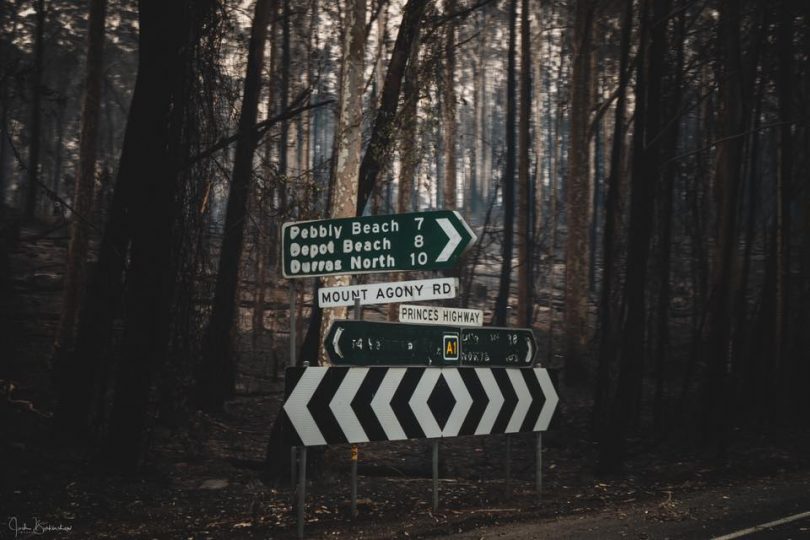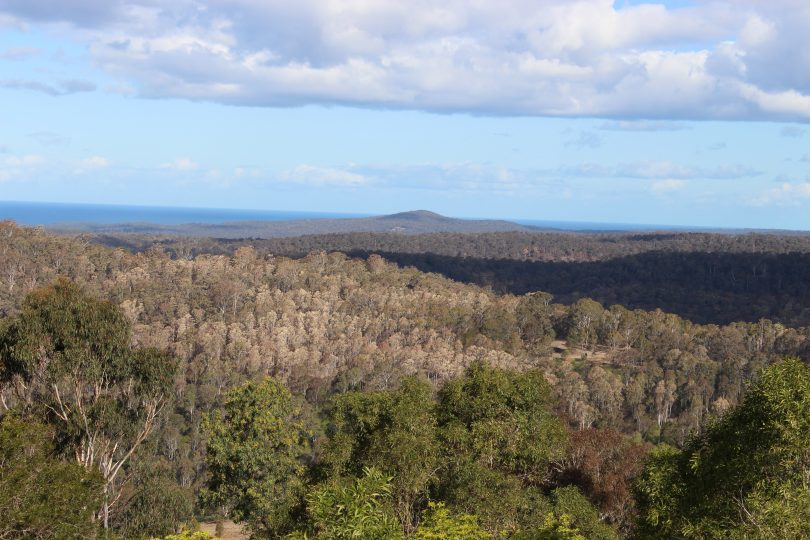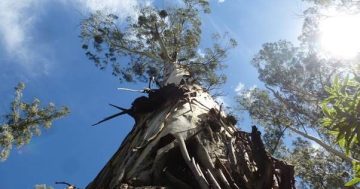
The Princes Highway shows the agony and scars of the Currowan Fire. Photo: Josh Burkinshaw Images.
Forest conservation groups around NSW are calling for a moratorium on logging operations until the impacts of drought and bushfires are assessed and addressed.
Nine organisations have written to NSW Premier Gladys Berjejiklian, including the South East Region Conservation Alliance (SERCA), asking for a halt to all logging in public native forests in order to mitigate habitat losses and to help forests recover as dry times bite hard.
SERCA spokesperson Harriett Swift says wildlife is struggling in the severe drought and faces enough of a challenge to survive without logging to contend with.
“Patches of apparently dying trees are now a common sight in the region’s forests,” she says.
“On the South Coast, the Currowan bushfire has at least six logging operations nearby either underway or planned in the near future. Logging in that area could be the last straw for many forest-dwelling creatures.
“Bushfires will make any surviving wildlife more vulnerable to starvation, loss of shelter and predation by feral predators.
“Further wildfires can be expected as summer progresses into our normal fire season. In any fire coming from the west there is increased risk of ember attacks on coastal towns.
“Debris left on the forest floor following recent logging operations at Mogo, Bodalla and Corunna pose serious risks to Malua Bay to Tomakin, Potato Point to Kianga and Mystery Bay. Our letter to the Premier asks at what point will common sense prevail?
“We are gravely concerned for the survival of our forest-dwelling wildlife and any continuation of logging activities in drought-stricken and burnt forests will greatly compound the impacts on surviving fauna, jeopardising their survival.
“Areas of forest which have not been affected by fire are more valuable than ever as refugia for our stressed and starving wildlife.
“They must be retained undisturbed as source areas for recolonisation of burnt forests.”
Other signatories of the letter to the NSW Premier include the North Coast Environment Council, North East Forest Alliance, the Friends of Kalang Headwaters, South East Forest Alliance, The Great Eastern Ranges, The Colong Foundation, Nambucca Valley Conservation Association and Boral Green Share Holders.

Patches of possibly dead and dying bush are being seen along the Far South Coast including the western side of Mumbulla and Doctor George Mountains, to the west of Moruya, and here at Black Range south of Bega, Photo: Ian Campbell.
Groups in Northern NSW, who have been living alongside bushfire for over a month, claim that “more than 1.7 million hectares of land has been impacted [by fire] in NE NSW alone, including more than six hundred thousand hectares of National Parks and more than three hundred thousand hectares of State Forests”.
“A third of native vegetation in NE NSW is mapped as being burned, including half of our remaining old-growth and a quarter of all rainforests.
“A third of the modelled high-quality koala habitat on public lands in north-east NSW has been burned, including some of our largest koala colonies on the Richmond lowlands, Dorrigo Plateau and around Lake Innes.
“Within the burned areas most leaves on the feed trees have been burnt, scorched or dropped, leaving surviving koalas with little to eat. It is still unknown how many koalas survived how many more will succumb to starvation, thirst or predation, or how long it will take for their trees to regenerate.”
The nine conservation groups point to an “over cut of more than 100,000 cubic metres of various classes of timber” across the north coast forestry region “which represents 6-9 months of logging so a moratorium could be put in place with no effect on Wood Supply Agreements in that region.”
Locally, SERCA spokesperson Harriett Swift says “we’re calling on the Government to stop logging these forests and instead assess what new role they might now play”.
NSW Environment Minister Matt Kean spoke this week about the need for greater action on climate change. While he didn’t deal with the issue of forestry specifically he has flagged the need for greater change and adaptation.
The Guardian reported that Mr Kean told the Smart Energy Summit that weather conditions were “exactly what the scientists have warned us would happen.”
“Longer drier periods, resulting in more drought and bushfire. If this is not a catalyst for change, then I don’t know what is.
“This is not normal and doing nothing is not a solution.
“We need to reduce our carbon emissions immediately, and we need to adapt our practices to deal with this kind of weather becoming the new normal.”
Original Article published by Ian Campbell on About Regional.













